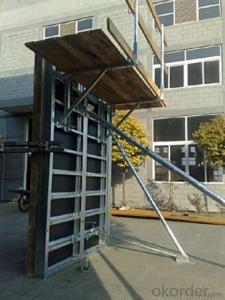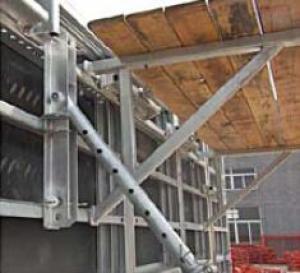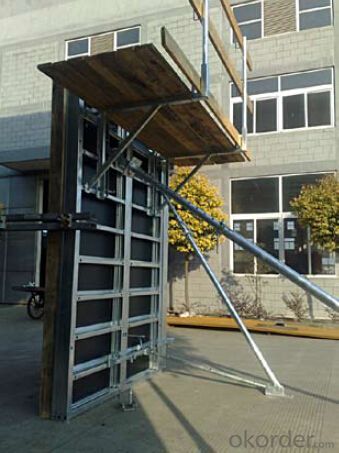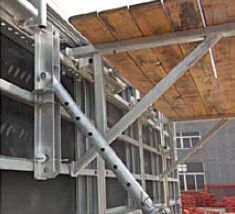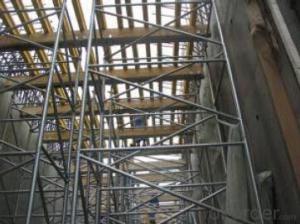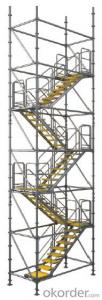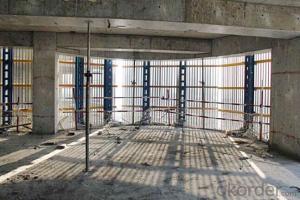Steel-Frame working platformfor Formwork and Scaffolding systems
- Loading Port:
- Tianjin
- Payment Terms:
- TT OR LC
- Min Order Qty:
- 50 m²
- Supply Capability:
- 1000 m²/month
OKorder Service Pledge
OKorder Financial Service
You Might Also Like
Steel-frame Formwork SF-140
Characteristics:
◆ Few parts for fast forming.
◆ Max. Concrete pressure: 80KN/m2.
◆ Hot-dip galvanized steel frame.
◆ The thickness of plywood is 18mm & the panel is 14cm.
◆ Compatibility with Hunnebeck Manto system due to similar edge profile.
System Details & Application:
◆ Neat joint and fast assembling with aligning panel clamp.
◆ Flexible panel arrangement and height extension.
◆ The selection of panels.
◆ Kinds of panel connectors.
◆ Corner clamp application.
◆ Length adjustment application.
◆ Height adjustment & aligning strut.
◆ Walkway bracket & platform.
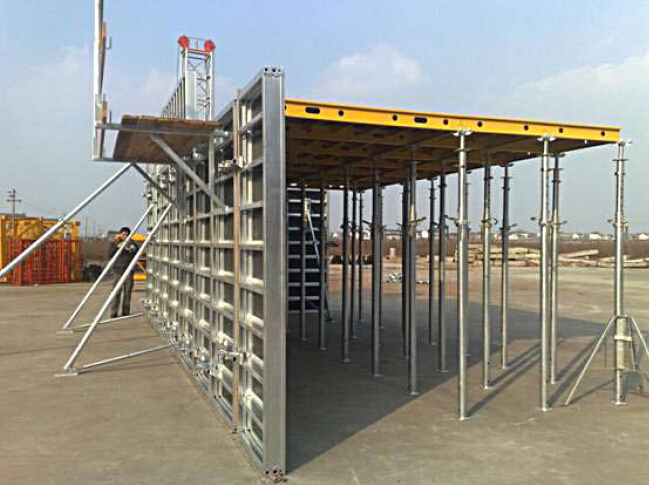

- Q: Can steel formwork be used for both straight and curved structures?
- Indeed, both straight and curved structures can utilize steel formwork. The versatility of steel formwork allows for effortless shaping and adjustment, enabling the construction of diverse geometric designs. These designs encompass straight walls, columns, arches, and curved walls. Such flexibility facilitates the realization of exceptional architectural concepts and structures. Moreover, the strength and durability of steel formwork render it appropriate for employment in both straight and curved structures.
- Q: Can steel formwork be used in areas with extreme temperature variations?
- Steel formwork is indeed capable of being utilized in regions with significant temperature fluctuations. Thanks to its high strength-to-weight ratio and resistance to thermal changes, steel is well-suited for diverse conditions. It can endure both high and low temperatures without experiencing structural deformity or deterioration. Moreover, steel formwork delivers exceptional stability and durability, guaranteeing its ability to withstand the strain caused by extreme temperature fluctuations. However, it is crucial to take into account the effects of thermal expansion and contraction when employing steel formwork in areas with substantial temperature variations, as these factors may influence the precision of the formwork and the ultimate concrete structure. By considering proper design aspects and employing appropriate installation techniques, any potential issues arising from temperature variations can be effectively managed.
- Q: Can steel formwork be used for decorative concrete finishes?
- Yes, steel formwork can be used for decorative concrete finishes. It provides sturdy support and precise shaping, allowing for intricate designs and smooth finishes in decorative concrete applications.
- Q: Can steel formwork be used for high-rise buildings?
- Yes, steel formwork can be used for high-rise buildings. Steel formwork offers several advantages such as durability, strength, and flexibility, making it suitable for large and complex structures like high-rise buildings. It can withstand the pressure exerted by concrete, ensuring structural stability during the construction process. Additionally, steel formwork allows for smooth and precise concrete finishing, facilitating the construction of high-quality, aesthetically appealing high-rise buildings.
- Q: Does steel formwork require special equipment for installation?
- Special equipment is necessary for the installation of steel formwork. Unlike traditional wooden or plastic formwork, steel formwork is heavier and stiffer, necessitating stronger and more specialized equipment for handling and installation. Cranes, forklifts, and hoists are commonly used to lift and position the steel panels and beams during installation. In addition, specific tools like clamps, braces, and connectors are required to secure the formwork system and maintain its stability while pouring concrete. The utilization of this specialized equipment not only simplifies the installation process but also guarantees the safety and stability of the formwork structure.
- Q: Position of horizontal construction joint of shear wall. The first layer is higher than the standard layer, the large template in accordance with the standard layer, the first part of the difference with the roof can be poured?
- Position of horizontal construction joint of shear wall. The first layer is higher than the standard layer height
- Q: What are the different types of steel formwork accessories available?
- In the market, one can find a variety of steel formwork accessories that serve different purposes. These accessories are specifically designed to improve the efficiency and effectiveness of steel formwork systems, thereby making the construction process smoother. Here are some commonly used types of steel formwork accessories: 1. Formwork clamps: These clamps are utilized to securely connect formwork panels, guaranteeing stability and preventing any movement while pouring concrete. They come in various sizes and shapes to fit different formwork systems. 2. Formwork ties: These ties are employed to hold formwork panels together and provide additional support. Formwork ties are available in different lengths and materials to meet various formwork requirements. 3. Formwork connectors: These connectors are used to join formwork panels at corners or intersections. They create a strong and secure connection, ensuring proper alignment and stability of the formwork system. 4. Formwork wedges: These wedges are used to adjust the inclination or angle of formwork panels. They are typically made of steel and can be easily inserted or removed to achieve the desired formwork configuration. 5. Formwork brackets: These brackets are utilized to vertically or horizontally support formwork panels. They are adjustable and can be easily installed or removed to accommodate different formwork configurations. 6. Formwork spacers: These spacers are used to maintain a specific spacing between formwork panels. They ensure consistent concrete thickness and prevent bulging or deformation during the pouring process. 7. Formwork props: These props are used to support the formwork system and provide additional stability. They can be adjusted in height and easily installed or removed as required. 8. Formwork anchors: These anchors are employed to secure the formwork system to the ground or existing structure. They provide stability and prevent any movement during the concrete pouring and curing process. Overall, these steel formwork accessories are crucial for ensuring the structural integrity and stability of the formwork system. They are designed to withstand high pressure and offer a reliable and efficient solution for construction projects.
- Q: How does steel formwork contribute to the strength and stability of a concrete structure?
- Steel formwork contributes to the strength and stability of a concrete structure by providing a rigid and durable framework that holds the freshly poured concrete in place until it sets and hardens. The steel formwork acts as a mold, ensuring that the concrete is poured into the desired shape and dimensions, and also prevents any deformation or collapse during the curing process. Its strength and stability ensure that the concrete structure maintains its integrity and can withstand various loads and forces, thereby enhancing its overall strength and durability.
- Q: What are the common design considerations for steel formwork in earthquake-prone areas?
- In earthquake-prone areas, the design considerations for steel formwork are crucial to ensure the safety and stability of structures during seismic events. Some common design considerations for steel formwork in earthquake-prone areas include: 1. Material Strength: The steel used in formwork should have high tensile strength to withstand the lateral forces generated during an earthquake. High-strength steel, such as Grade 60 or Grade 80, is commonly used in earthquake-resistant formwork designs. 2. Reinforcement: The formwork should be adequately reinforced to enhance its rigidity and resistance to seismic forces. Additional reinforcement can be provided by adding steel braces, cross-bracing, or diagonal members to increase the structural integrity of the formwork system. 3. Connection Details: The connection details between different formwork elements should be designed to withstand the dynamic forces induced by earthquakes. Welded or bolted connections are commonly used, ensuring that they have adequate strength and ductility to resist seismic loads. 4. Stiffness and Flexibility: The formwork system should exhibit an appropriate balance between stiffness and flexibility. It should be rigid enough to resist lateral forces during an earthquake but also flexible enough to absorb and dissipate seismic energy without collapsing. 5. Anchorage Systems: Anchorage systems are crucial in securing the formwork to the foundation or supporting structure. These systems should be designed to resist the uplift and lateral forces generated during an earthquake and prevent the formwork from overturning or sliding. 6. Diaphragm Action: To enhance the overall structural performance, the formwork system should be designed to provide diaphragm action. This means that the formwork acts as a continuous and rigid panel transferring forces across its surface, thereby reducing localized stresses and improving the overall stability of the structure during an earthquake. 7. Formwork Compatibility: The steel formwork should be compatible with other structural elements, such as concrete columns, beams, and slabs. It is essential to ensure that the formwork system can adequately transfer the loads from the concrete to the supporting structure without compromising its stability or integrity during seismic events. 8. Construction Practices: In addition to design considerations, proper construction practices play a vital role in ensuring the effectiveness of steel formwork in earthquake-prone areas. Adequate bracing and temporary supports should be used during formwork assembly to maintain stability and prevent collapse before the concrete is poured and hardened. By considering these design considerations, engineers and designers can develop robust steel formwork systems that can withstand the forces exerted by earthquakes and ensure the safety of structures in seismic regions.
- Q: Can steel formwork be used for airport runway construction?
- Airport runways can indeed be constructed using steel formwork. Steel formwork is a versatile and durable option for building concrete structures, including runways. It offers numerous advantages compared to other forms of formwork, such as timber or aluminum. To begin with, steel formwork provides a high level of strength and stability, ensuring an efficient and accurate concrete pouring process. This is crucial in runway construction, as the surface must be even and strong enough to withstand heavy aircraft traffic. Additionally, steel formwork is reusable, making it cost-effective for large-scale projects like airport runways. Its durability allows for multiple uses, reducing the need for frequent replacements and saving both time and money. Moreover, steel formwork can be easily assembled and disassembled, making it convenient for construction sites with tight schedules or limited space. Its modular design allows for quick installation and adjustment, enabling efficient construction progress. Furthermore, steel formwork exhibits excellent resistance to various weather conditions, including extreme temperatures and moisture. This is vital for airport runways, which endure constant wear and tear from aircraft as well as harsh weather conditions. In conclusion, steel formwork is a suitable choice for airport runway construction due to its strength, reusability, ease of use, and resistance to different weather conditions. Its ability to provide a stable and durable surface makes it an ideal option for creating runways capable of handling heavy aircraft traffic.
Send your message to us
Steel-Frame working platformfor Formwork and Scaffolding systems
- Loading Port:
- Tianjin
- Payment Terms:
- TT OR LC
- Min Order Qty:
- 50 m²
- Supply Capability:
- 1000 m²/month
OKorder Service Pledge
OKorder Financial Service
Similar products
Hot products
Hot Searches
Related keywords
